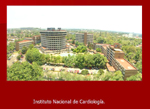|
|
|

|
Global
health
 Mexico—Medicine
after the Revolution Mexico—Medicine
after the Revolution
|
by Leticia Reyes
and Ricardo Moreno
MUSC Regenerative
Medicine and Cell Biology
After the Mexican Revolution in 1910, Mexican physicians quickly
adapted to the new way of thinking and induced fundamental changes in
medicine, education and science.
These changes were associated with the creation of several medical
institutions. The first was the Department of Cardiology in 1924, which
was headed by Ignacio Chavez, M.D., and, in 1944, the new National
Institute of Cardiology of Mexico was created. This institute was the
first of its kind in the world to focus on cardiac medical research and
teaching. It was also the first institute to garner international
status.
Chavez used murals painted by the famous Mexican muralist Diego Rivera
displayed on the entrance of the main building in the institute to show
the cardiology history starting from the time of Galen. Agustin
Castellanos, M.D., established Intracardiac Catheterism, the
procedure of passing a catheter through the lumen of an artery and
injecting contrast media to get a clear image of the heart. This
technique was later modified by Swedish cardiologists and currently is
known as angiocardiography. The prestigious school of
electrocardiography surged in this institute, gaining worldwide
recognition, under the direction of Demetrio Sodi Pallares, M.D.,
and Enrique Cabrera, M.D., and foreign collaborators.
The School of Pathology and Anatomy developed under the leadership of
Isaac Costero, M.D., as did the School of Physiology with Arturo
Rosenblueth, M.D., a pioneer in cybernetics and the founder of the
Center of Scientific Research and Advanced Studies, which has
international status. In 1950, pediatric cardiology became a recognized
strength in Mexico because of the knowledge of Jorge Soberon, M.D., and
Jorge Espino-Vela, M.D., and the revolutionary studies related to the
embryological development of the heart by Maria de la Cruz, M.D.
De la Cruz was the first to show that the ventricles are anatomical
units, not embryological units. De la Cruz is perhaps best known for
her elegant in-vivo mapping studies. Her investigations with Ricardo
Moreno, M.D., showed that the tubular heart is constituted only by the
primordial apical, trabecular regions of both ventricles and that new
cellular populations are added at both ends of this primitive heart.
Although de la Cruz was a morphologist, the last decade of her life was
focused on the integration of the morphological changes with the
underlying molecular and biochemical mechanisms, with the collaboration
of Roger Markwald, M.D., of MUSC, who is one of the best in his field.
Together, they wrote the book “living morphogenesis of the heart.”
 The Instituto
Nacional de Cardiologia was the first hospital in the country to use
the Gore Helex Septal Occluder for the transcatheter closure of an
atrial septal defect. Department chief, Dr. Carlos Zabal, and Dr. Jose
Garcia Montes achieved the milestone procedure in March. The Instituto
Nacional de Cardiologia was the first hospital in the country to use
the Gore Helex Septal Occluder for the transcatheter closure of an
atrial septal defect. Department chief, Dr. Carlos Zabal, and Dr. Jose
Garcia Montes achieved the milestone procedure in March.
The National Institute of Cardiology of Mexico, has been a seminal
leader in the field of cardiology with accomplishments that have
attracted national and foreign cardiologists of international stature.
Facts about Mexico
- At the beginning
of the 21st century, Mexico’s population was more than 100 million.
- Mexico City is
sinking at a rate of 10 inches a year because it’s built on top of an
underground reservoir.
- Wells are drawing
out more and more water for the city’s growing population of more than
15 million people.
- Mexico introduced
chocolate to the world.
- Hot chocolate is
the sacred drink of the Aztecs.
- In the fourteenth
to sixteenth centuries, the Aztecs used the poinsettia leaves to dye
fabric for clothing and the sap for medicinal purposes, including to
help control fevers.
- Dr. Joel Roberts
Poinsett, an amateur botanist and first United States ambassador to
Mexico, introduced the plant that became known as the poinsettia to
this country.
- If you love
Starbucks, you won’t find one in Mexico.
- Tequila is the
national drink.
- Mexico is the
largest salt producer in the world.
- Mexico has the
world’s smallest volcano. It is 43 feet tall and has a staircase inside.
- The country has
the oldest living tree in the world. It is 40 feet tall.
Clinician’s corner
A 30-year-old female traveled to Guadalajara, Mexico, for a two-week
vacation. About a week into her vacation, she became ill with abdominal
cramping, mild nausea, and nonbloody diarrhea. The most likely cause of
her symptoms is which of the following pathogens:
A) Giardia lamblia
B) Entamoeba histolytica
C) Shigella dysenteriae
D) Enterotoxigenic Escherichia coli
E) Norwalk virus
The correct answer is D, Enterotoxigenic E. coli or ETEC, which is one
of the most common etiologies of traveler’s diarrhea, especially in
Latin America. Transmission usually occurs via contaminated food or
water. Onset of diarrhea is often abrupt after a 14-50 hour incubation
period. As with any diarrheal illness, fluid replacement is the
principal component of treatment. A quinolone antibiotic such as
ciprofloxin can also be used to shorten the duration of diarrhea.
Announcements
International
Peace Day
Sept. 21
Visit
http://www.internationaldayofpeace.org
Charleston Peace
One Day
Sept. 19: Charleston Peace One Day is devoted to creating more peaceful
communities through educational programs and community activities that
teach children and adults how to use non-violent conflict resolution
tactics in order to solve conflicts in their life. Visit http://www.cp1d.org.
Oyster Roast and
Fun Night
MUSC internationals and families
6 to 8 p.m., Sept. 29, Redeemer Presbyterian Church, 43 Wentworth St.,
downtown Charleston
International
Book Club
Held from 5:30 to 6:30 p.m., Oct. 6, Suite 224 Harper Student Center.
First selections from ‘Ourselves Among Others—Readings from Home and
Abroad’ by Carol Verburg. All MUSC students and postdocs are invited.
Visit http://www.musc.edu/international
Friday, Sept. 3, 2010
|
|
|



 Mexico—Medicine
after the Revolution
Mexico—Medicine
after the Revolution